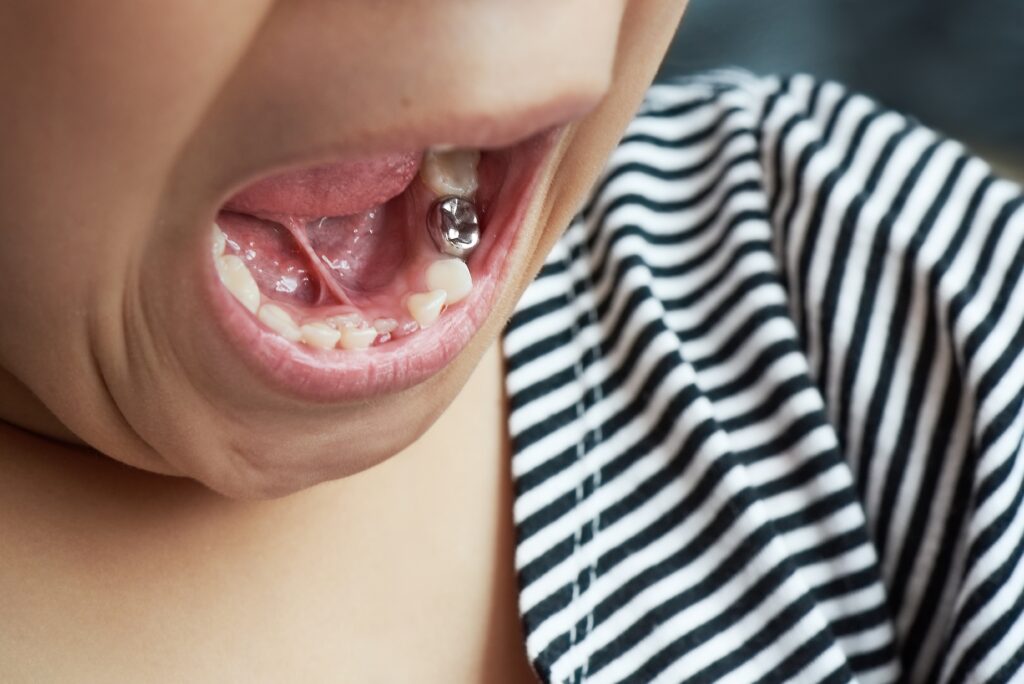Tooth decay is the most common dental issue in children under five.
Treating tooth decay in children’s primary teeth is important because of the role these teeth play in healthy oral development. They help children chew properly, aid in speech development, and act as placeholders for permanent teeth.
If a child has a primary tooth with severe decay or damage, a pediatric dentist might suggest treating it with a stainless steel crown. Keep reading to learn more about stainless steel crowns and whether they are safe for children!
Stainless steel crowns are prefabricated metal caps that cover and protect a primary tooth. They are often used as an alternative to more expensive zirconia crowns.

They are designed to cover the entire visible portion of the tooth, sealing it off from surrounding teeth. They help support healthy alignment and prevent further decay or damage.
These crowns are composed of three metals: stainless steel (the main component), nickel, and chromium (which give the crowns strength and durability). These metals are similar to those used for traditional braces, or jewelry.
Stainless steel crowns are primarily used in pediatric dentistry. They often treat the following:
Extensive Decay
Stainless steel crowns can cover a primary tooth that has decay on several surfaces, which often occurs on primary molars. They are preferable to traditional fillings because they are better at preventing further decay.
After Root Canal Treatment
If the pulp under a primary tooth becomes infected, it may require root canal treatment, which can weaken the tooth’s structure. A stainless steel crown can strengthen and protect tooth functionality.
Fractured Teeth
Accidents happen, and if a tooth has been cracked or fractured due to a mishap, a stainless steel crown can encase the damaged tooth, protecting it from further damage and providing stability.
Tooth Decay Prevention
If a child is prone to decay or has a history of extensive decay, stainless steel crowns can prevent future cavities and protect vulnerable teeth. They can be placed on a single tooth or multiple teeth in areas of concern.
Understandably, parents or caregivers might have concerns about the safety of placing a metal crown over their child’s tooth. However, the stainless steel that makes up most of the crown is biocompatible and usually well-tolerated by surrounding gum tissues, minimizing safety risks.
One possible issue a child might have with these crowns is a metal allergy. The nickel content in a stainless steel crown can trigger an allergic reaction and cause symptoms like redness, swelling, and discomfort around the gum line where the crown has been placed.
If a child is known to have an allergy or sensitivity to nickel, a pediatric dentist could use a crown made of other materials, such as composite resin or porcelain. These crowns tend to be less durable and more expensive than stainless steel, but they can provide similar levels of tooth protection.
The placement of a stainless steel crown is similar to getting a filling. Typically, the procedure follows these steps:
The dental cement that holds the crown in place can take up to 12 hours to fully set. Children should eat softer foods during that time to ensure the crown stays firmly in place.
A stainless steel crown typically stays in place until the primary tooth it covers falls out naturally. These crowns are highly durable and can withstand the force of chewing and biting for many years without becoming damaged.
Rarely, a stainless steel crown may need to be replaced due to wear or damage. Because the crown is attached to the tooth with dental cement, a pediatric dentist can easily remove and replace it.
Stainless steel crowns offer several benefits over other types of pediatric crowns. These benefits include:
Durability: As mentioned above, stainless steel crowns are extremely durable, making them ideal for protecting teeth that endure significant chewing forces, like molars.

Comprehensive Protection: By encasing the entire tooth in durable stainless steel, the crown shields it from further decay or damage.
Cost-Effective: Stainless steel crowns are often more affordable than other treatment options, such as composite resin or porcelain crowns.
Single-Visit Placement: Treating a tooth and placing the crown can typically be completed in a single appointment.
Supports Healthy Alignment: Stainless steel crowns restore the size and shape of an affected tooth, ensuring surrounding teeth remain in healthy alignment.
If a young child develops tooth decay in their primary teeth, timely treatment is essential to their current and future dental health. Stainless steel crowns are a safe and effective way to protect young smiles.
Do you want to learn more stainless steel crowns? Schedule an appointment at Premier Pediatric Dentistry in Coral Gables, FL, today!





